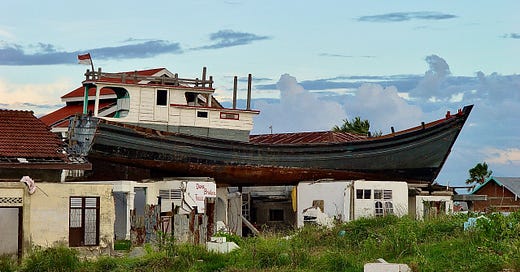It's what happens when the world is not looking that counts the most
A look back on events in Indonesia following the 2004 Indian Ocean tsunami
The image above is from the photographic collection of Peter Rancie. He was in Banda Aceh, Indonesia, at the beginning of 2005, following the Indian Ocean tsunami of December 26, 2004.
At the time I was 30, a young mother, with the first of my six boys.
I knew about that event, and though I had already been in many countries, served numerous missions, and had seen first hand the plight of the poor, I wasn't paying much attention to the news, being preoccupied with a very young life that was completely dependent on me.
However, Peter was in the thick of things, working with NGOs and UN agencies trying to accelerate housing solutions for those left homeless after the tsunami.
His observations from that time suggest that, "The world tends to focus on the sensational more than the problem." He spent a year, with many others, orchestrating housing solutions for Indonesians displaced from their homes. However, he relates, "Momentum for housing solutions had been gathering steam, but disappeared almost instantly in the second half of that year, when Hurricane Katrina hit the US southern coast and an earthquake devastated the Kashmir sector of Pakistan."
Indonesia, already used to shanty communities surrounding its major cities, largely went back to the status quo, while fortunes had been spent, or stolen (he witnessed both), and little changed for the hundreds of thousands still left homeless.
A million people (based on the assessment of the former governor of Aceh), were swept out to sea in one terrible moment, but little changed for those left behind whose homes and families had been swept away.
He told me about meeting a man scrabbling amongst a pile of rubble on a tiny house site. Peter learned that man’s story with the help of an interpreter (the former governor of the province who was acting as a consultant to Peter’s housing project). The man had ten children, but his wife and nine children had been swept away by the tsunami. Even in such dire, heartbreaking circumstances, little could be done to help him rebuild because the title records (his and most others) were also carried away by the flood. So he camped in a makeshift tent, with his only remaining child, like a miner staking a claim.
His tragic story had hundreds of thousands of counterparts. Together, they formed a Gordian knot beyond the ken and the motivations of governments and NGO’s. And the world’s attention moved to the next spotlight.
So, what is the world's current focus? Did the Russia-Ukraine war cease, or has the world's attention moved on to King Charles' health, or the Olympics, or the US presidential race, or, well, whatever.
While all those major stories are newsworthy and some of them are important, the focus of our reporting and that of our staff avoids the sensational and looks for the sustainable. We aim to highlight those whose efforts are productive, meaningful, sustainable, and scalable to deliver change at the national, regional, or global level, regardless of the news cycles. §





